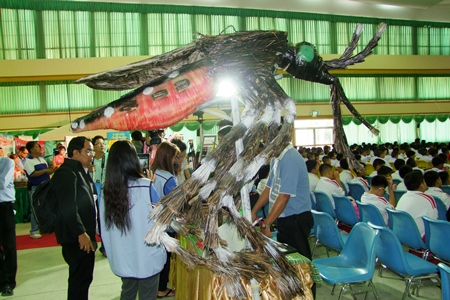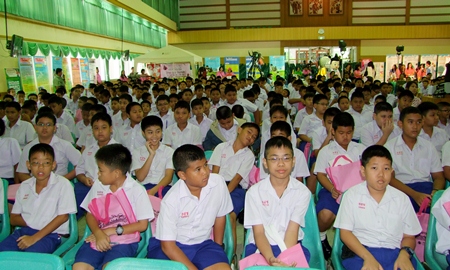The director-general of Thailand’s Disease Prevention and Control Department visited a Sriracha school to review measures to prevent dengue fever and other mosquito-borne diseases.
Dr. Pornthep Siriwanarangsun joined Dr. Samai Kangsuan of the Chonburi Public Health Department and Sriracha Permanent Secretary Phawat Khantthhiran at Assumption School May 29 to review prevention and eradication projects employed in the region.
 Dr. Pornthep Siriwanarangsun, with help from a quartet of mascots, teaches students at Assumption School how to avoid getting dengue fever and how to get rid of mosquitoes.
Dr. Pornthep Siriwanarangsun, with help from a quartet of mascots, teaches students at Assumption School how to avoid getting dengue fever and how to get rid of mosquitoes.
Among those is a project by Ban Klong 17 Health Promotion Hospital in Chachoengsao, which cleans the inside of water tanks before each refill to remove mosquito eggs. Workers also inspect full tanks by submerging compact discs in the water to reflect light emitted by flashlights, which boosts detection of larvae.
Elsewhere in the area, residents are using plastic bottles to catch mosquitoes and larvae, and planting lemongrass, which acts as a natural bug deterrent.
Pornthep said 35,150 cases of dengue fever were reported in Thailand through May 28. Forty patients died, an increase of more than 300 percent from 2012. The majority of victims range in age from 15 to 24, with more than half that group comprised of students.
Sriracha officials told Pornthep that schools stress the “5 Ps, 1 E” principal, which lays out five preventative steps and one eradication measure to take.
The preventative steps are closing lids covering water buckets and tanks, changing water in vases and tanks weekly, allowing fish to eat larvae in permanent water-storage reservoirs, maintaining cleanliness and ventilating water-storage areas, and repeating each “P” until mosquitoes are gone.
As for eradication, the focus falls on ridding residential water sources of any larvae.







